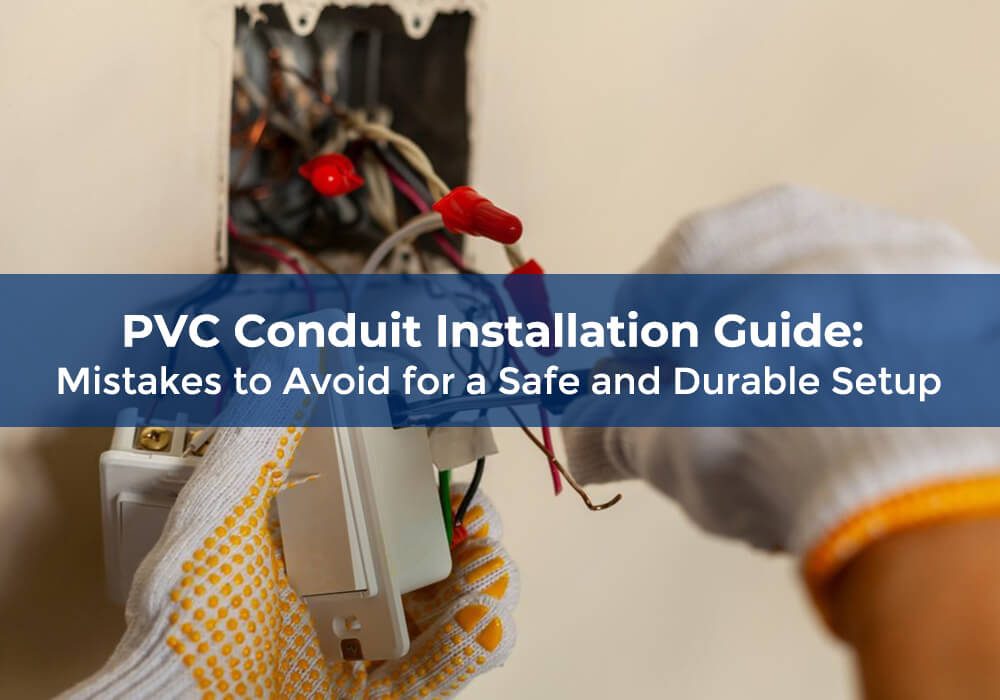Common PVC Conduit Pipe Installation Mistakes and How to Avoid Them
When it comes to electrical wiring, proper conduit installation is crucial for safety and longevity. While it may seem like a straightforward process, even small mistakes can cause big problems down the line. In this post, we’ll go over some common PVC conduit pipe installation mistakes and how to avoid them.
Common PVC Conduit Pipe Installation Mistakes
- Using the wrong type of conduit: Not all PVC conduit pipes are created equal. Depending on the location, environment, and purpose of your installation, you may need to choose a specific type of conduit. For example, if your conduit will be exposed to sunlight or high temperatures, you’ll want to use UV-resistant or high-temperature conduit.
- Improperly securing the conduit: PVC conduit pipes need to be secured properly to prevent sagging or shifting over time. Failing to use enough brackets or straps can cause the conduit to bend or even fall off the wall, leading to cable damage or restricted airflow.
- Not accounting for expansion and contraction: PVC conduit pipes can expand and contract with changes in temperature. If you don’t leave enough space or use the proper supports, your conduit may buckle or crack over time.
- Using too many bends: While PVC conduit pipes are flexible and easy to bend, excessive bending can cause kinks or blockages that prevent cable from passing through. Using too many bends can also put unnecessary stress on the conduit and make it more likely to crack or break.
- Not properly gluing joints: When joining PVC conduit pipes, it’s important to use primer and cement to create a strong, leak-proof seal. Failing to do so can result in separation or leaks, which can lead to water damage, electrical shock, or even fire.
The Consequences of PVC Conduit Pipe Installation Mistakes
Each of the mistakes listed above can have serious consequences if not addressed. Here are some potential problems you could encounter:
- Corrosion and degradation: Using the wrong type of conduit or failing to glue joints can lead to corrosion, degradation, or even melting over time. This can compromise the integrity of your installation and put your cables at risk.
- Sagging or shifting: Improperly secured conduit can sag or shift over time, potentially causing cable damage or restricted airflow.
- Cracking or breaking: If you don’t account for expansion and contraction or use too many bends, your PVC conduit pipes may crack or break, leading to costly repairs.
- Restricted airflow or cable damage: Excessive bending or blockages can restrict airflow and cause heat buildup, which can damage your cables and create a fire hazard.
- Leaks or separation: Failing to properly glue joints can result in leaks or separation, which can cause water damage or electrical shock.
How to Avoid Common PVC Conduit Pipe Installation Mistakes
Fortunately, most PVC conduit pipe installation mistakes can be avoided with proper planning and execution. Here are some tips for getting it right:
- Choose the right type of conduit: Take into account the location, environment, and purpose of your installation, and choose a PVC conduit pipe that meets your needs.
- Secure the conduit properly: Use enough brackets or straps to prevent sagging or shifting over time.
- Allow for expansion and contraction: Leave enough space and use the proper supports to account for changes in temperature.
- Minimize the number of bends: Use only the bends you need and make sure to use proper bending techniques to avoid kinks or blockages.
- Use primer and cement to properly glue joints: Follow the manufacturer’s instructions to create a strong, leak-proof seal.
Conclusion
When it comes to PVC conduit pipe installation, taking the time to get it right can save you a lot of trouble and expense down the line. By avoiding common mistakes like using the wrong type of conduit, not properly securing the conduit, not accounting for expansion and contraction, using too many bends, and not properly gluing joints, you can ensure a safe and reliable installation that will last for years to come.
By choosing the right type of conduit, securing it properly, allowing for expansion and contraction, minimizing the number of bends, and using primer and cement to properly glue joints, you can avoid the potential problems that can arise from poor PVC conduit pipe installation.
In conclusion, proper PVC conduit pipe installation is a critical aspect of any electrical wiring project. By taking the time to plan and execute your installation properly, you can avoid the common mistakes listed above and ensure a safe, reliable, and long-lasting installation.
Common PVC Conduit Pipe Installation Mistakes and How to Avoid Them Read More »

